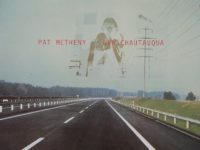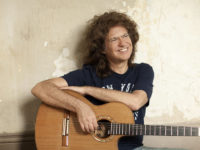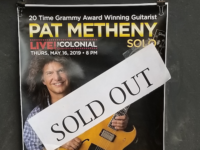One night back in the late 1970s, me and my cousin Andy were playing a game of backgammon (cripes, that really was a long time ago … I remember there was a Styx Grand Illusion poster on the wall and … uh, anyway) … he had this album playing on his turntable.
The record itself had a pretty interesting cover photo full of Airstream trailers. But more important, it contained a kind of music that I was totally unfamiliar with. For one thing, the bass was way more active than on my rock records. And then there was the cool piano (and other keyboards), things that at that time I would only tolerate on Steely Dan records. Most important of all: the guitar … gees, what the hell was that guy doing? Chiming, elongated tones … crazy (to me) twists of logic. This wasn’t rock, but I was strangely attracted to it.
The record was American Garage by the Pat Metheny Group.
Then, many years later, I’m sitting here at my desk, late at night with everybody else gone to bed, giving a first listen to Pat’s latest: One Quiet Night, a solo acoustic guitar record. I’ve been a big fan of Pat Metheny ever since hearing that odd little record in my cousin’s room. And over all of those years I’ve been rewarded with a huge variety of listening experiences:
— “modern” jazz (I will not use the fusion-word here ’cause it’s just too loaded a subject): “Cross The Heartland” from American Garage
— abstract, free play: “Offramp” from Offramp, all of Song X, and The Sign Of 4
— Americana (of the midwest type): As Falls Wichita, So Falls Wichita Falls, Beyond The Missouri Sky
— soundscapes: “Half Life of Absolution” from The Road To You and the title track from Imaginary Day
— Brazilian-flavored jazz: Still Life (Talking)
— straight-ahead jazz: Question And Answer, Bright Size Life, Trio 99>00
— soundtracks: A Map Of The World, The Falcon And The Snowman
— …and delicate, fingerstyle acoustic play: New Chautauqua
Long-time Metheny fans have long treasured their copies of New Chautauqua. While Pat has made several fantastic duet recordings (with jazz giants Charlie Haden and Jim Hall, just to name a couple), only New Chautauqua has the intimacy that a solo recording can produce. Most of us had been waiting (and hoping) for another set of solo guitar from Pat. That time finally came with One Quiet Night.
The album was indeed recorded during one evening at Pat’s home studio. From the liner notes:
On November 24, 2001, I went to my home studio, turned on the recorder, and spent the evening playing. I had rediscovered a special low Nashville tuning that I had worked with many years ago (on the tune “The Search”) and applied it to a recently acquired baritone guitar. The combination of this wonderful new instrument (made by Canadian luthier Linda Manzer) and this unusual tuning not only made some different things possible harmonically, but challenged me to think about ways of playing that i wouldn’t have normally thought to go. I found and settled into a very specific mood of simple, mostly quiet playing, really just for myself. Listening back to that recording over the next year of touring, I realized that i had inadvertently started on the road to doing something that had been lingering in the back of my mind for awhile – to one day think about making a whole record with one single guitar, no overdubs or extra parts; to do a totally solo acoustic guitar record – in this case, on the baritone guitar.
Late in 2003, Pat filled out the set by recording a few of his favorite songs (“My Song” and “Ferry Cross The Mersey”), a cover of Norah Jones’ “Don’t Know Why,” a couple of new tunes (“Song For The Boys” and “Over On 4th Street”) and finally, a new version of his own “Last Train Home.”
To call this record New Chautauqua II is to do a disservice to both recordings. While there were certainly elements of New Chautauqua here, One Quiet Night was more focused, more intent … on developing that singular mood. It was very pretty … but somehow managed to be quite intense at the same time. As with all of Pat’s records, it took a while before the “whole” revealed itself.
And that’s what I love about music like this. It’s a little like poetry, except that it’s a distillation of a musical idea … and every time I “read” it, a new thought surfaces.
[amazon_enhanced asin=”B0027M70AM” container=”” container_class=”” price=”All” background_color=”FFFFFF” link_color=”000000″ text_color=”0000FF” /] [amazon_enhanced asin=”B0000261O4″ container=”” container_class=”” price=”All” background_color=”FFFFFF” link_color=”000000″ text_color=”0000FF” /] [amazon_enhanced asin=”B002Y27P3M” container=”” container_class=”” price=”All” background_color=”FFFFFF” link_color=”000000″ text_color=”0000FF” /] [amazon_enhanced asin=”B0000ZOSZ8″ container=”” container_class=”” price=”All” background_color=”FFFFFF” link_color=”000000″ text_color=”0000FF” /] [amazon_enhanced asin=”B0000261LA” container=”” container_class=”” price=”All” background_color=”FFFFFF” link_color=”000000″ text_color=”0000FF” /]
- Why the Rolling Stones’ Harrowing ‘Gimme Shelter’ is Still Revealing New Depths - November 18, 2024
- How Talking Heads’ ‘Fear of Music’ Opened Up a World of Art and Sound - August 5, 2024
- How Deep Cuts Propelled Bruce Springsteen’s ‘Born in the U.S.A.’ - June 4, 2024




